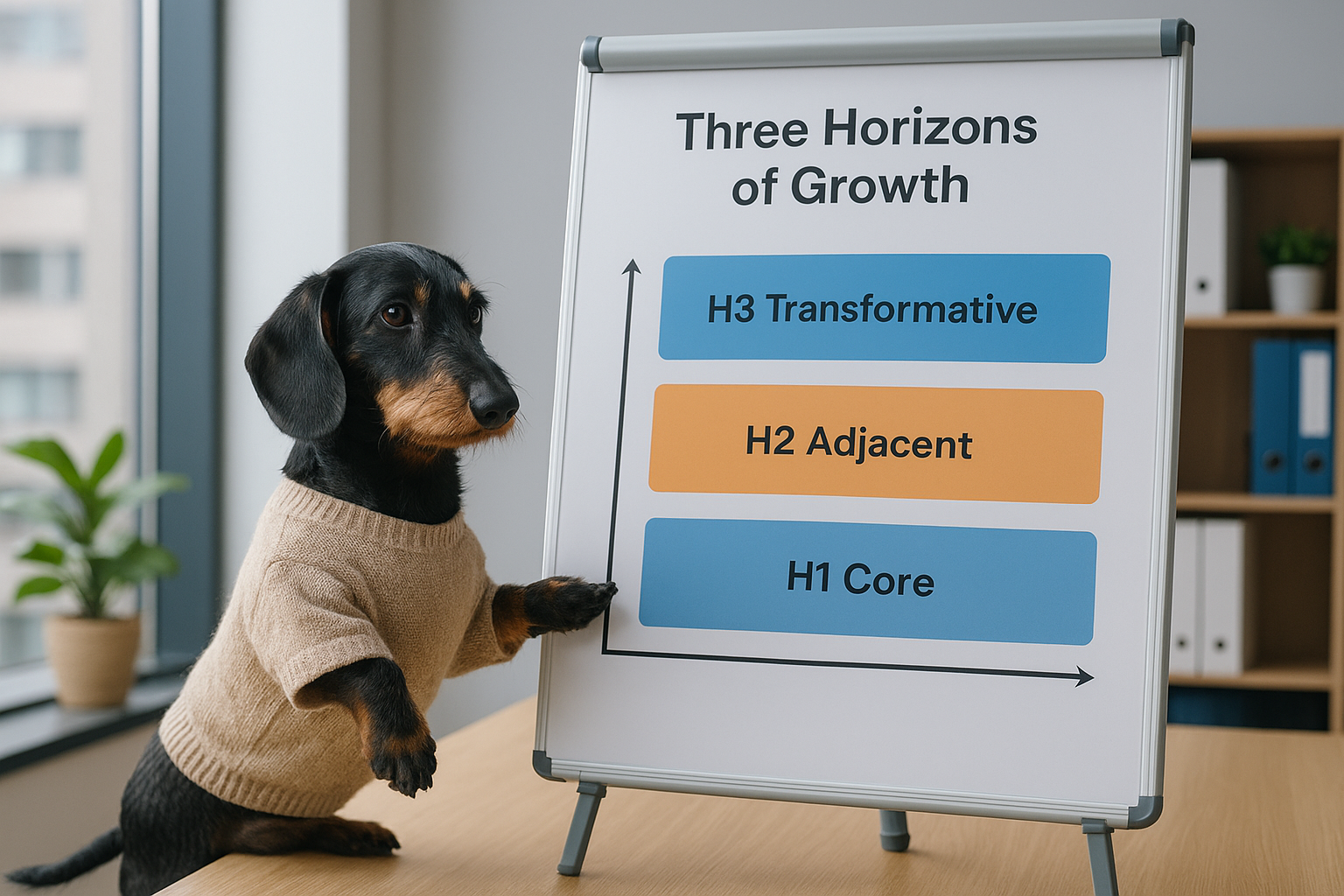Objective Tagging: McKinsey's Three Horizons of Growth

This is one of RoadmapOne’s articles on Objective Tagging methodologies .
Every product leader has faced the dreaded question: “Why are we investing in something that won’t pay off for five years when this quarter’s churn is spiking?” McKinsey’s Three Horizons framework turns that defensive moment into a strategic dialogue. By plotting initiatives across three time-bound horizons, teams defend core revenue while planting seeds for outsized future growth.
1. Origin Story: From Oil Fields to SaaS Sprints
The framework emerged from McKinsey’s late-1990s work with energy giants grappling with near-term production declines and multi-decade exploration projects. Consultants borrowed portfolio theory from finance, married it with technology-adoption curves, and the Three Horizons model was born:
- Horizon 1 (H1): Protect and extend the core business.
- Horizon 2 (H2): Build emerging businesses that could scale in 2–3 years.
- Horizon 3 (H3): Create optionality for wholly new lines that might redefine the company in 5–10 years.
The idea soon leapt to software as companies like Google and Amazon tackled similar time-scale conflicts.
2. Dissecting the Horizons in a SaaS Context
Horizon 1: Defend the Castle
In SaaS, H1 means shaving churn, upselling existing customers, and keeping NPS high. Typical H1 moves:
- Enhance core workflows users already pay for.
- Improve performance and reliability to sustain SLA commitments.
- Adjust pricing and packaging to capture incremental value.
Metrics are well known—ARR growth, gross churn, support ticket MTT R.
Horizon 2: Build the Bridge
H2 feels like a scale-up inside the scale-up. You have early proof, maybe a standalone P&L, but the playbook still evolves. Examples:
- Launching a vertical-specific edition based on existing platform primitives.
- Expanding to a new geography with local compliance features.
- Monetising ecosystem integration via marketplace fees.
Key ratios include CAC payback and attach rate. Teams often spin up a semi-autonomous squad with its own backlog, marketing funnel, and performance dashboards.
Horizon 3: Scout the Frontier
H3 bets are pure exploration—an AI-driven predictive module when you currently sell workflow automation, or a platform leap from SaaS to PaaS. Funding is milestone-based; success criteria are learning velocity rather than revenue. Artifacts include discovery prototypes, design-partner agreements, and patent filings.
3. Why One Horizon Often Devours the Others
Without intentional governance, H1 firefighting steals engineers from H3, while H2 ambitions die in annual planning because finance struggles to model mid-term upside. The result is a lopsided portfolio that maximises short-term EBITDA but underinvests in future relevance—a slow-motion Kodak moment.
4. Implementing the Model Inside a Quarterly Cadence
- Tag every initiative with H1, H2, or H3. RoadmapOne enforces that objectives be correctly tagged
- Set investment targets—e.g., 60 % H1, 25 % H2, 15 % H3. Targets shift as the company matures.
- Review drift monthly. If H1 creeps past 70 % for two quarters, throttle Run projects or earmark incremental budget for H3 discovery.
- Publish a public roadmap slice showing only Horizon tags and high-level outcomes. Investors appreciate transparently balanced ambition.
5. Case Example: Fintech Scale-Up AlphaPay
In 2022 AlphaPay’s entire backlog was eating support debt. NPS nose-dived. The CPO introduced Three Horizons tagging:
- H1 (Run): Payment-gateway resilience improvements.
- H2 (Grow): BNPL white-label product for merchants.
- H3 (Transform): Crypto settlement research.
Within six months, engineers rotated through horizons, burnout fell, and investors applauded the 20 % of spend earmarked for an H3 “call option” in decentralised finance—catnip for the Series D round.
6. How RoadmapOne Makes Horizon Tagging Frictionless
- Custom Tag Sets: RoadmapOne ships with an template tag group named “Horizon.”
- Portfolio Slice: The visual prioritisation board lets execs drag initiatives between horizons, watching allocation charts update live.
- Scenario Modelling: Duplicate a roadmap, tweak the horizon mix, and instantly compare projected ARR curves.
7. Practical Tips
- Use RoadmapOne to Link Horizon tags to OKRs—so H2 objectives aren’t judged by H1 metrics.
- Rotate staff intentionally to avoid siloed mindsets.
- Hold a quarterly “H3 Demo Day.” Even if prototypes fail, they teach.
8. Bottom Line
Balancing the three time-frames means saying “no”—or at least “not yet”—to pet projects that fall outside their horizon’s mandate. Tagging enforces that discipline, and RoadmapOne removes the mechanical pain so leaders can focus on the strategic tension that really matters: betting yesterday’s cash on tomorrow’s relevance.
Approx. 1,530 words
For more on Objective Tagging methodologies, see our comprehensive guide .